Disclosure: Meeple Mountain received a free copy of this product in exchange for an honest, unbiased review. This review is not intended to be an endorsement.
In the city of Meepletonshirevillesburg (a name I totally made up), the downtown district is a bustling hub of meeple-driven commerce. As such, there is a desperate need for more space for meeples to live, thrive, and grow.
The players represent contractors tasked with the construction of this real estate. Using the cards in their hands and the game pieces at their disposal, they will take turns adding to the construction site growing between them in an effort to outscore the other players. Points are earned by adding Level tiles to the construction, providing the supports that hold the floors up, Bonus tiles collected during the game, and leftover workers when the game comes to an end. The player with the most points wins.
This is an oversimplification of course. If you’d like to learn how the game is played, then keep on reading. Otherwise, feel free to skip ahead to the Thoughts section.
Laying the Groundwork
Every construction project requires a bit of preparation. Meeple Towers may look imposing when you first open the box, but the setup (and game play) is actually pretty straightforward. To begin, each player will choose one of the available colors and take the wooden pieces and card decks matching their chosen color. The Score Marker is placed on the zero spaces of the score track and the players may need to return some of their supports to the box depending on the player count.
After this, the Property board is assembled by connecting one of the matched sets of Property board halves. The rule book suggests some pairings for your first play, but these can later be mixed and matched however you choose once you become more familiar with the game.
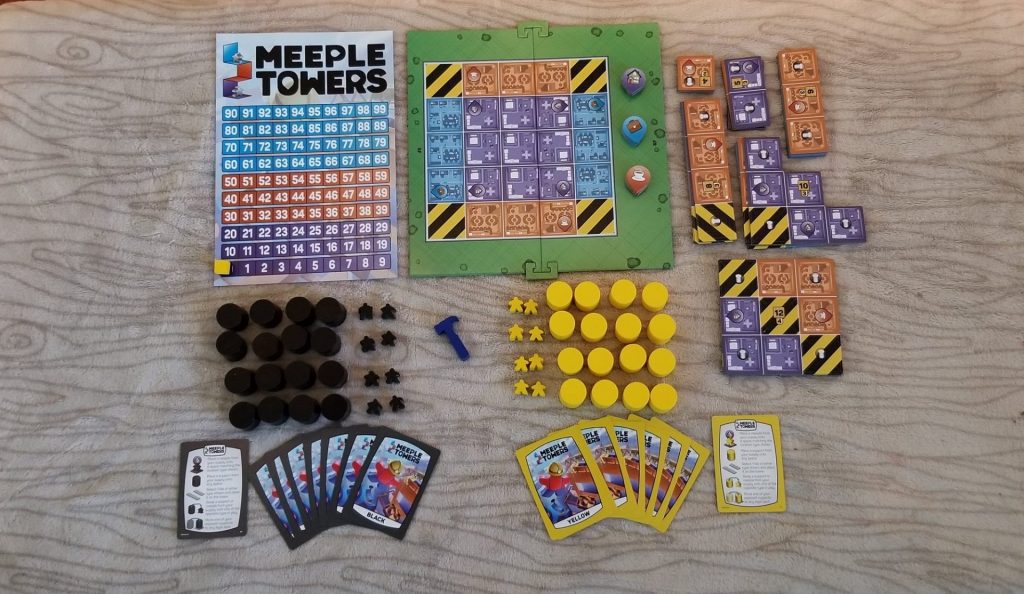 Next, the Level tiles are sorted by size and each stack is shuffled together. Each of these tiles has a basic side and an advanced side. After the players agree on which type of game to play, these tiles should be turned with the appropriate side face up. The Bonus Point tokens are separated by type, shuffled, and placed into face down stacks. The score track is placed within easy reach, a starting player is selected and given the Start Player token, and you are ready to begin.
Next, the Level tiles are sorted by size and each stack is shuffled together. Each of these tiles has a basic side and an advanced side. After the players agree on which type of game to play, these tiles should be turned with the appropriate side face up. The Bonus Point tokens are separated by type, shuffled, and placed into face down stacks. The score track is placed within easy reach, a starting player is selected and given the Start Player token, and you are ready to begin.
Meeples at Work
With the groundwork laid, you’re ready to begin constructing your towers. What you can construct and where it can be constructed are dictated by a few simple rules and the deck of cards in your hand (each player has the exact same set of cards). On your turn you may choose from one of two actions: play a card or collect all of the cards that you have previously played. While the second option is pretty self-explanatory, the first option requires a bit more explanation.
With the exception of the Reference card (which should be set aside), each card in a player’s hand is divided in two halves representing different possible actions. When selecting a card to play, the player will also choose which of the two available actions to use. Without getting into the specifics about each card, the available actions fall into a few categories: adding supports, adding workers, constructing Level tiles, swapping supports for workers (or vice versa), and moving supports around. Some cards mix and match these options.
Adding Supports
The player takes the matching number of supports from their supply and places them onto any location on the board with a few exceptions. The support cannot occupy the same space as a worker. The support cannot be stacked atop a support that was placed as part of the same action. It can, however, be placed atop an existing support so long as the stacks of supports never exceed two. The support cannot be placed beneath an existing Level tile. In fact, a player may never construct anything at all beneath an existing Level tile. This is referred to as “the Golden Rule” in the rule book, so I will use that nomenclature here as well.

Adding Workers
The player takes the matching number of workers from their supply and places them into a location matching the type indicated on the card (purple, orange, or blue) following the Golden Rule. No two workers may ever occupy the same space.
Constructing Level Tiles
The player takes the top tile from a stack of one of the matching shapes and adds it to the Property board following the Golden Rule. Each Level tile depicts a number of icons that look like a support surrounded by a circle. This indicates that a support MUST be beneath that portion of the tile. The tile must also be constructed so that it is perfectly level.
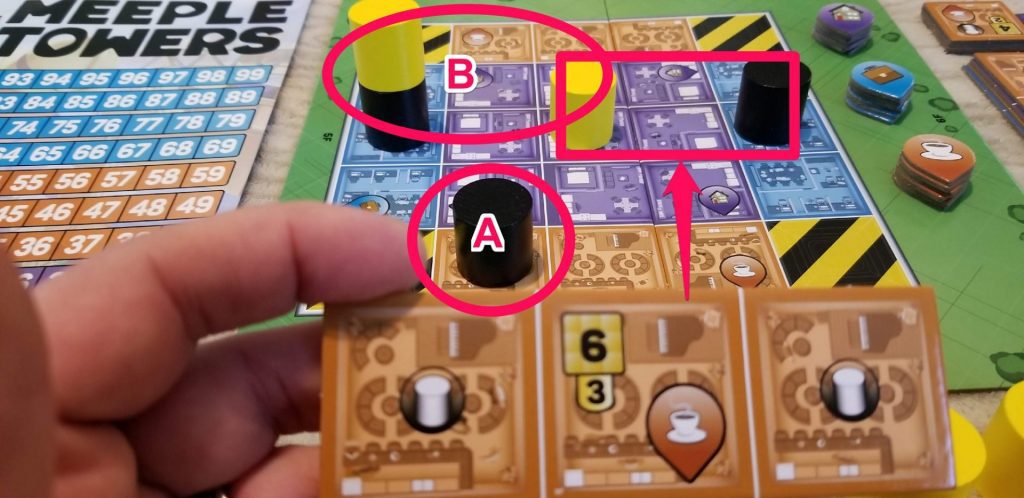
The player that builds the Level tile immediately scores points equal to the number shown in the large square. Then each player with supports directly beneath the tile will score points equal to the smaller number times the number of supports they have directly beneath it. If there is a worker present beneath the Level tile that is being constructed, then it is returned to its owner who then collects one of the face down Bonus tiles of the matching type. The tiles have different values that are kept hidden and will be added to their owners’ scores at the end of the game.
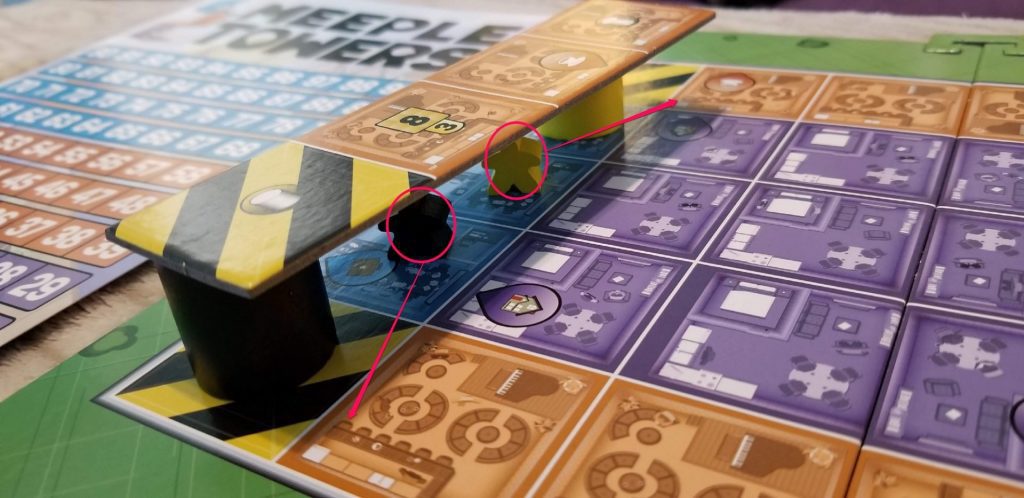
Swapping Things
The player takes a worker from their supply and replaces one of their already placed supports with the worker or they replace an already placed worker with a support from their supply.

Moving Supports
The player may move one of their exposed supports (not supporting a Level tile) from one area of the board to another following the Golden Rule.

Construction Complete
Standing on the ground and looking up at your completed project fills you with a sense of pride and satisfaction. The end game of Meeple Towers is triggered in one of several ways: a player has placed all of their supports, one stack of Level tiles has been exhausted, or two types of Bonus tokens have been exhausted. When this happens, the current round is completed and final scoring is performed.
Players score points for their leftover workers based on how high up in the tower the worker has been placed. Meeples on the lowest level (i.e. the Property board itself) are worth one point each with each successive floor being worth one additional point each. And when I say “floors” I don’t mean the number of Level tiles themselves. I mean the number of supports beneath the level on which the worker currently stands.

After factoring this total along with the victory points earned during the game and victory points earned from Bonus tiles, the player with the most points wins the game.
Thoughts
Full disclosure here: Because of COVID-19 restrictions and because Meeple Towers does not exist on any digital platform that I have access to, I have only ever played Meeple Towers at the 2-player count. I just wanted to get that out there before I go any further because, spoilers, my thoughts on Meeple Towers are not very uplifting ones.
Meeple Towers at the 2-player count is fundamentally flawed. From the very first game I ever played of Meeple Towers with my wife, we both noticed that the first person to place a support onto the board is already at a disadvantage because that automatically sets up their opponent for a scoring opportunity. If I place a support and my opponent has held back their card that allows them to place a one-tile floor, then they can capitalize by placing that on top of my support netting them 4 points and me just 2 (since my support was beneath it). We did not immediately realize the full importance of this observation and we chugged along in that learning game trying out various combinations of cards and strategies. In the end, our scores were decently high, up in the 30-40 range, and our grand totals only differed by a few measly points. We walked away from that first game thinking that Meeple Towers was… alright. Nothing great, but not too terrible either.
It wasn’t until our second game, and every single game after that, that we realized just how flawed Meeple Towers really is (at least at the 2-player count). In our second game, having gained the understanding that the first person to drop a support allows the other person to immediately score points, we both did everything that we could to avoid dropping one. We used every card in our hand that allowed us to place workers onto the board until there weren’t any more workers in our pool to place. The person that comes after whoever placed their last worker is left with 1 of 2 viable options: either place supports or collect their cards. So they collect their cards. We’ll call this person Player 1. Then the other person, not wanting to be the first to place a support, collects their cards. We’ll call this person Player 2.
Now Player 1 only has a single viable option: use the double support card, as there are no cards that allow you to place a single support without also placing a worker along with it. So, to minimize the chances of Player 2 scoring big, they’ll place their supports at opposite corners of the board.
 Player 2, unsurprisingly, capitalizes by building a one-tile floor. The score is now 2-4 in Player 2’s favor.
Player 2, unsurprisingly, capitalizes by building a one-tile floor. The score is now 2-4 in Player 2’s favor.
 Player 1 capitalizes on the other support by building a one-tile floor. They score a cool 6 points. The score is now 8-4 in Player 1’s favor.
Player 1 capitalizes on the other support by building a one-tile floor. They score a cool 6 points. The score is now 8-4 in Player 1’s favor.
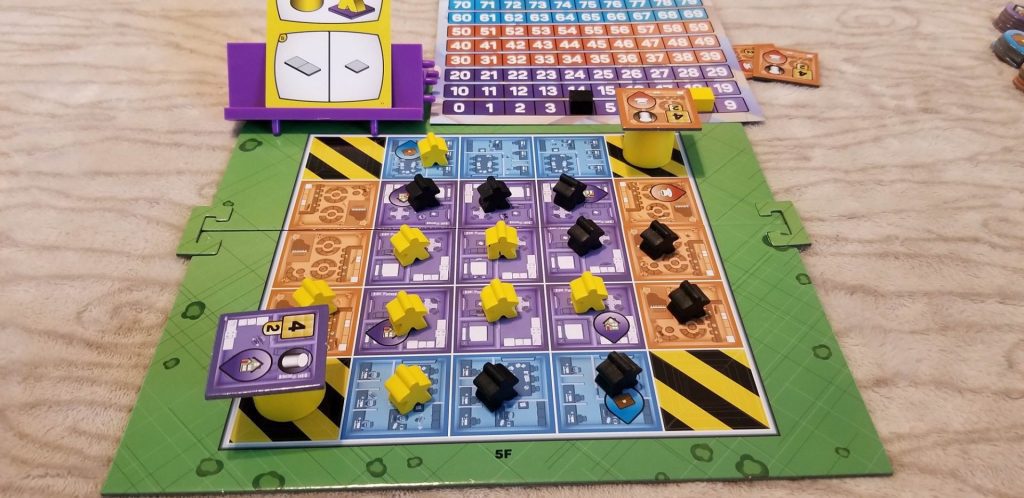 Player 2 does not want to play supports, so they collect their cards and Player 1 does the same for the same reasons. Now Player 2 is faced with two viable options: use the double support or swap a worker in play for a support from their supply. This, however, would leave Player 1 with another unanswered opportunity to score which would ultimately lose Player 2 the game. So they place 2 supports in the remaining opposing corners.
Player 2 does not want to play supports, so they collect their cards and Player 1 does the same for the same reasons. Now Player 2 is faced with two viable options: use the double support or swap a worker in play for a support from their supply. This, however, would leave Player 1 with another unanswered opportunity to score which would ultimately lose Player 2 the game. So they place 2 supports in the remaining opposing corners.
Player 1 capitalizes with a one-tile floor scoring them 4 points and scoring Player 2 another 2. The score is now 12-6 in Player 1’s favor. Now Player 2 capitalizes with a one-tile floor scoring them 6 points. The score is now 12-12. This triggers the end of the game since the entire stack of one-tile floors has run out. It doesn’t matter if one of the players still gets another turn because their only remaining options are to place 2 supports or swap a worker for a support from the supply which would break the tie during end-of-game scoring. So, they’d place their 2 supports and be done with it. Factor in points for leftover workers and the end score is 20-20.
 Now that the players are tied at the end of the game, we look at the tie breaker rules. The tie breaker is awarded to the player with the worker at the highest level. Well, both players have every one of their workers at the very lowest level, so the tie is never broken even though the rule book seems to assume that it will be. Even using the advanced side of the tiles, the game still ends in a tie, albeit a 16 point tie. I can’t even say anything positive about the artwork. While it’s functional, it’s pretty bland.
Now that the players are tied at the end of the game, we look at the tie breaker rules. The tie breaker is awarded to the player with the worker at the highest level. Well, both players have every one of their workers at the very lowest level, so the tie is never broken even though the rule book seems to assume that it will be. Even using the advanced side of the tiles, the game still ends in a tie, albeit a 16 point tie. I can’t even say anything positive about the artwork. While it’s functional, it’s pretty bland.
Maybe if the rule book allowed you to play a card and optionally use it (or even just use a portion of an action instead of the whole thing) instead of making it mandatory, the game might have been more interesting at a 2-player count. Or perhaps if the end game triggered after 2 stacks of tiles had run out things might be different. I find it surprising that the only changes for a 2-player game are in the game boards and the number of supports used. Maybe if there was more fine tuning for the 2-player experience, I’d have walked away with a much higher opinion of the game. As it stands now, though, I can’t in good conscience recommend Meeple Towers as a good 2-player game because it just isn’t. Not unless you’re willing to implement one (or both) of the changes I suggested here. It’s a bummer, too, because I really wanted to like it.
For what it’s worth, I actually implemented the “2 stacks used” end condition and it really did make for a much more interesting game. The game played out predictably until all four of the one-tile floors had been used. Then it became much more difficult to do things that didn’t result in the other person scoring. That being said, I’m generally not a fan of having to house rule a game to make it interesting.


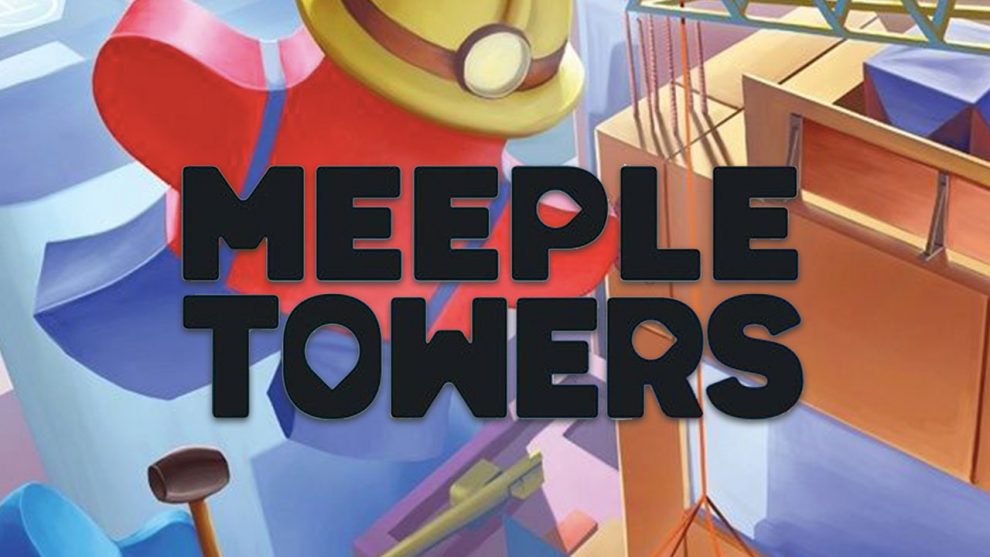









Not my style of game, but a good review! Thanks!
I think you’ve misread the end conditions.
You have to exhaust both 1-tile and 2-tile floors before the game ends. Or 3&4 , or 6&9.
That said I haven’t played a 2-player game yet so unsure if the strategy holds.